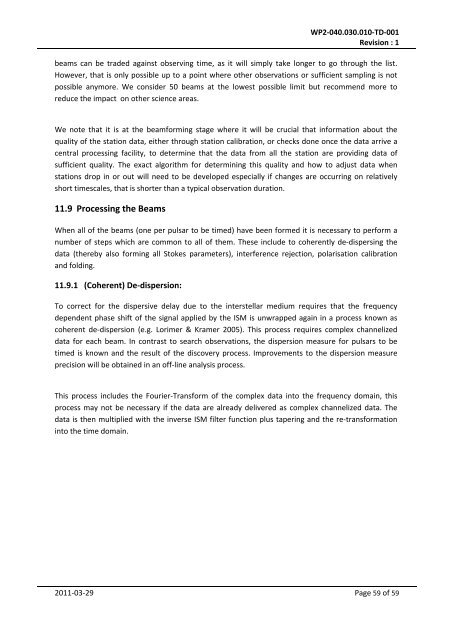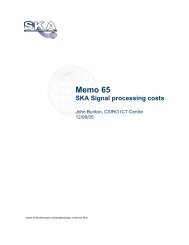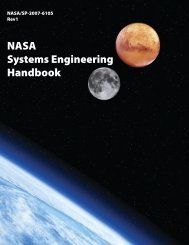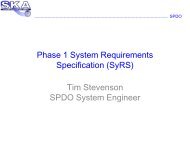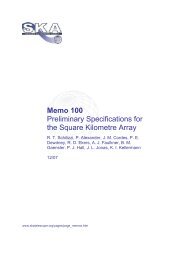high-level ska signal processing description - The Square Kilometre ...
high-level ska signal processing description - The Square Kilometre ...
high-level ska signal processing description - The Square Kilometre ...
Create successful ePaper yourself
Turn your PDF publications into a flip-book with our unique Google optimized e-Paper software.
WP2‐040.030.010‐TD‐001<br />
Revision : 1<br />
beams can be traded against observing time, as it will simply take longer to go through the list.<br />
However, that is only possible up to a point where other observations or sufficient sampling is not<br />
possible anymore. We consider 50 beams at the lowest possible limit but recommend more to<br />
reduce the impact on other science areas.<br />
We note that it is at the beamforming stage where it will be crucial that information about the<br />
quality of the station data, either through station calibration, or checks done once the data arrive a<br />
central <strong>processing</strong> facility, to determine that the data from all the station are providing data of<br />
sufficient quality. <strong>The</strong> exact algorithm for determining this quality and how to adjust data when<br />
stations drop in or out will need to be developed especially if changes are occurring on relatively<br />
short timescales, that is shorter than a typical observation duration.<br />
11.9 Processing the Beams<br />
When all of the beams (one per pulsar to be timed) have been formed it is necessary to perform a<br />
number of steps which are common to all of them. <strong>The</strong>se include to coherently de‐dispersing the<br />
data (thereby also forming all Stokes parameters), interference rejection, polarisation calibration<br />
and folding.<br />
11.9.1 (Coherent) De‐dispersion:<br />
To correct for the dispersive delay due to the interstellar medium requires that the frequency<br />
dependent phase shift of the <strong>signal</strong> applied by the ISM is unwrapped again in a process known as<br />
coherent de‐dispersion (e.g. Lorimer & Kramer 2005). This process requires complex channelized<br />
data for each beam. In contrast to search observations, the dispersion measure for pulsars to be<br />
timed is known and the result of the discovery process. Improvements to the dispersion measure<br />
precision will be obtained in an off‐line analysis process.<br />
This process includes the Fourier‐Transform of the complex data into the frequency domain, this<br />
process may not be necessary if the data are already delivered as complex channelized data. <strong>The</strong><br />
data is then multiplied with the inverse ISM filter function plus tapering and the re‐transformation<br />
into the time domain.<br />
2011‐03‐29 Page 59 of 59


